Lesson 4 – Evolution of Nocturnes
Introduction
“Look how the Japanese understand this! the same colour reappearing continually here and there like the same thread in an embroidery … the whole forming in this way an harmonious pattern”
- James McNeill Whistler to Henri Fantin-Latour
“As the light fades and the shadows deepen, all petty and exacting details vanish, everything trivial disappears, and I see things as they are in great strong masses … And that, night cannot efface from the painter's imagination.”
– - James McNeill Whistler
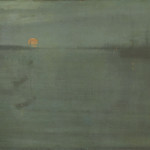
Today we take abstract art for granted. In the 20th-Century it was the norm. However, in the 1850’s “fine art” conveyed a story or a moral and always had recognizeable subjects. But Whistler questioned this. Wasn’t a piece of art an object? Couldn’t it be just a beautiful arrangement of line, form, and color? As he studied Japanese composition and color harmonies, his art gradually transitioned from Realism to simplified, almost abstract subjects. This led to his confrontation with traditional art critic, John Ruskin, in a memorable trial of aesthetics – tradition vs. avant-garde.
In this lesson students view and discuss a Japanese woodblock print to discover Eastern art’s influence on Whistler. After studying Andō Hiroshige’s print Nihonbashi, Whistler’s Arrangement in Grey and Black No.1, Portrait of the Artist's Mother, and Nocturne: Blue and Gold--Southampton Water, students compare and contrast the three artworks on a Venn diagram. They read Whistler’s defense of his art in an excerpt from the Whistler v. Ruskin trial and roleplay this trial. Then they write a critical analysis of Whistler’s Nocturne in Black and Gold, the Falling Rocket. Students paint a scene from memory using color to indicate mood and write an artist statement about their painting.
Abstract
In this lesson students learn how James McNeill Whisler’s art transitioned from realism towards abstraction. By viewing a Japanese woodblock print they discover how the artwork, namely the prints, influenced Whistler’s art. They compare and contrast a Hiroshige print with Whistler’s Arrangement in Grey and Black No.1, Portrait of the Artist's Mother and Nocturne: Blue and Gold--Southampton Water. After reading Whistler’s defense of his art in the trial Whistler v. Ruskin, they dramatize the trial. Students write a critical analysis of Whistler’s Nocturne in Black and Gold, the Falling Rocket. Students paint a landscape from memory using color to indicate mood and write an artist statement about their painting.
Downloads
» Lesson 4.0: Main Lesson Overview (Word Document)
» Lesson 4.0: Main Lesson Overview (PDF Document)
» Lesson 4.0 - 4.4: All Lesson Files (Compressed Folder - Word Documents)
» Lesson 4.0 - 4.4: All Lesson Files (Compressed Folder - PDF Documents)
» Lesson 4: All Images (Compressed Folder - JPG Files) [19.6 mb]
Guiding Questions
Learning Objectives
Abstract
In this lesson students watch a short video of artist and printmaker Norman Ackroyd demonstrating etching. Students review the etching process and illustrate steps in the process on the Etching Terms and Materials worksheet. They study Whistler’s drawing technique and composition in two of his etchings, The Lime-Burner and The Doorway. After observing how he created dark and light values with lines and how he often framed views with entries, students draw an entryway and the view seen through it. They write a reflection on their drawing. An assessment rubric for the drawing and reflection is included.
Objectives
At the end of this lesson students will be able to:
- Compare and contrast Hiroshige’s Japanese woodblock print Nihonbashi with Whistler’s paintings Arrangement in Grey and Black No.1, Portrait of the Artist's Mother and Nocturne: Blue and Gold--Southampton Water.
- Explain Japanese influences of color and composition in Whistler’s paintings.
- Discuss the transition in Whistler’s painting style from his early realism to the near abstraction of his mature paintings.
- Write a critical analysis of Whistler’s Nocturne in Black and Gold, The Falling Rocket.
- Dramatize the debate on aesthetics in the Whistler v. Ruskin trial to show their understanding of the clash between traditional 19th-Century art conventions and those of avant-garde artists creating “art for art’s sake.”
- Paint a landscape from memory using colors to suggest mood.
- Write artist statements explaining their paintings.
Background for Teachers
Hiroshige
Japanese artist Andō Hiroshige was born in Edo (modern Tokyo) in 1797. His original name was Ichiyusai Tokutaro, but his professional name was Utagawa Hiroshige. Although he inherited a fire warden position from his father, by 1811 he was studying art. Edo was a prosperous commercial center where Hiroshige designed ukiyo-e prints. These genre pictures of Edo’s stylish, fleeting, ”floating world” featured familiar scenes, everyday life and Edo’s entertainers.
Hiroshige’s print Nihonbashi was from his series Famous Views of 53 Stations of the Tokaido Road, 1855. This vertical composition shows a bird’s eye view of the bridge at the Nihonbashi station on the Tokaido Road. Mt. Fuji rises in the distant background. To learn more about Hiroshige and ukiyo-e see:
» The Floating World of Ukiyo-E (includes Hiroshige’s sketchbooks)
Library of Congress Exhibit
» Japan Memories of a Secret Empire
PBS video and website
Learn more about Japanese woodblock printing in Lesson 2 on this site.
Whistler’s Mother
James McNeill Whistler’s mother, Anna McNeill Whistler, joined him in London in 1863 when she fled North Carolina during the American Civil War. In 1871 she was living with him when he explored color and composition in his famous portrait of her. After a serious illness in 1875, Mrs. Whistler moved south to seaside Hastings, England, where she died in 1881.
Learn more about Anna McNeill Whistler and her family at:
NCpedia
» http://ncpedia.org/biography/whistler-anna-mathilda
Preparing to Teach This Lesson
Review the lesson plan and the websites used throughout. Locate and bookmark suggested materials and websites. Download and print out documents you will use. Duplicate copies as necessary for student viewing.
Students can access materials at http://www.whistlerthemovie.com.
Suggested Activities
Click any Activity heading to view that particular Activity in it's entirety (on the Activities Tab above). The corresponding documents are available for download below each Activity's respective heading.
» Activity 1. Compare and Contrast the Hiroshige print Nihonbashi, Portrait of Artist’s Mother, and Nocturne Southampton Water
» Lesson 4.1 Small Images and Quotes Sheet (Word Document).
» Lesson 4.1 Small Images and Quotes Sheet (PDF Document).
» Lesson 4.2 Compare Hiroshige, Mother, Nocturne Worksheet (Word Document).
» Lesson 4.2 Compare Hiroshige, Mother, Nocturne Worksheet (PDF Document).
» Art Image: Hiroshige, Nihonbashi, 1855
» Art Image: Whistler, Arrangement in Grey and Black No.1, Portrait of the Artist's Mother, 1871
» Art Image: Whistler, Nocturne: Blue and Gold--Southampton Water, 1872
» Activity 2. View Falling Rocket
» Activity 3. Read Whistler v. Ruskin: Aesthetics on Trial
» Lesson 4.3 Whistler v. Ruskin: Aesthetics on Trial (PDF Document).
» Activity 4 Assessment. Write an Analytical Criticism of Nocturne in Black and Gold, The Falling Rocket
» Lesson 4.4 Assessment of Critical Analysis of Falling Rocket assignment (PDF Document).
» Activity 5 Studio. Paint a Nonliteral Scene from Memory
» Activity 6 Lesson Extension: Hiroshige and Whistler Comparison
» Activity 7 Lesson Extension: Compare Bridges by Hiroshige, Whistler and Monet
» Activity 8 Lesson Extension: Read an Art Review
Extending the Lesson
» Activity 6 Lesson Extension: Hiroshige and Whistler Comparison
Compare and Contrast
Direct students to the following images and consider if they are alike in subject, color, and composition:
» Art Image: Hiroshige’s Nihonbashi, 1855
» Art Image: Whistler’s Brown and Silver: Old Battersea Bridge
» Art Image: Old Battersea Bridge
» Activity 7 Lesson Extension: Compare Bridges by Hiroshige, Whistler and Monet
» Activity 8 Lesson Extension: Read an Art Review
Handouts
» Lesson 4.1 Small Images and Quotes Sheet (Word Document).
» Lesson 4.1 Small Images and Quotes Sheet (PDF Document).
» Lesson 4.2 Compare Hiroshige, Mother, Nocturne Worksheet (Word Document).
» Lesson 4.2 Compare Hiroshige, Mother, Nocturne Worksheet (PDF Document).
» Lesson 4.3 Whistler v. Ruskin: Aesthetics on Trial (Word Document).
» Lesson 4.3 Whistler v. Ruskin: Aesthetics on Trial (PDF Document).
» Lesson 4.4 Assessment of Critical Analysis of Falling Rocket assignment (Word Document).
» Lesson 4.4 Assessment of Critical Analysis of Falling Rocket assignment (PDF Document).
Download ALL Lesson 4 Handouts:
» Lesson 4.0 - 4.4: All Lesson Files (Compressed Folder - Word Documents)
» Lesson 4.0 - 4.4: All Lesson Files (Compressed Folder - PDF Documents)
Other Resources
Edsitement Lesson Plans
The Basics
Grade Levels |
6-8 or 9-12 |
|
|---|---|---|
Subject Areas: |
Art and Culture: Literature and Language Arts: |
Visual Arts, Art History Common Core |
Time Required: |
4 or 5 periods |
Standards Alignment
» National Core Arts Standards: National Visual Arts Standards
VA:Cr2.1.8
Demonstrate willingness to experiment, innovate, and take risks to pursue ideas, forms, and meanings that emerge in the process of art-making or designing.
VA:Cr3.1.7
Reflect on and explain important information about personal artwork in an artist statement or another format.
VA:Re7.2.HSIII
Determine the commonalities within a group of artists or visual images attributed to a particular type of art, timeframe, or culture.
VA:Re8.1.6
Interpret art by distinguishing between relevant and non-relevant contextual information and analyzing subject matter, characteristics of form and structure, and use of media to identify ideas and mood conveyed.
VA:Re8.1.HSIII
Analyze differing interpretations of an artwork or collection of works in order to select and defend a plausible critical analysis.
VA:Re9.1.8
Create a convincing and logical argument to support an evaluation of art.
VA:Re9.1.HSII
Determine the relevance of criteria used by others to evaluate a work of art or collection of works.
» Common Core State Standards Initiative – English Language Arts Standards
Determine an author's point of view or purpose in a text in which the rhetoric is particularly effective, analyzing how style and content contribute to the power, persuasiveness or beauty of the text.
Integration of Knowledge and Ideas:
» CCSS.ELA-LITERACY.RI.11-12.7
Integrate and evaluate multiple sources of information presented in different media or formats (e.g., visually, quantitatively) as well as in words in order to address a question or solve a problem.
Introduce precise, knowledgeable claim(s), establish the significance of the claim(s), distinguish the claim(s) from alternate or opposing claims, and create an organization that logically sequences claim(s), counterclaims, reasons, and evidence.
Produce clear and coherent writing in which the development, organization, and style are appropriate to task, purpose, and audience.
Pose and respond to specific questions with elaboration and detail by making comments that contribute to the topic, text, or issue under discussion.
Interpret information presented in diverse media and formats (e.g., visually, quantitatively, orally) and explain how it contributes to a topic, text, or issue under study.
Author’s name and affiliation:
Art education consultant
Corpus Christi, Texas
Learning Objectives
Abstract
In this lesson students watch a short video of artist and printmaker Norman Ackroyd demonstrating etching. Students review the etching process and illustrate steps in the process on the Etching Terms and Materials worksheet. They study Whistler’s drawing technique and composition in two of his etchings, The Lime-Burner and The Doorway. After observing how he created dark and light values with lines and how he often framed views with entries, students draw an entryway and the view seen through it. They write a reflection on their drawing. An assessment rubric for the drawing and reflection is included.
Objectives
At the end of this lesson students will be able to:
- Compare and contrast Hiroshige’s Japanese woodblock print Nihonbashi with Whistler’s paintings Arrangement in Grey and Black No.1, Portrait of the Artist's Mother and Nocturne: Blue and Gold--Southampton Water.
- Explain Japanese influences of color and composition in Whistler’s paintings.
- Discuss the transition in Whistler’s painting style from his early realism to the near abstraction of his mature paintings.
- Write a critical analysis of Whistler’s Nocturne in Black and Gold, The Falling Rocket.
- Dramatize the debate on aesthetics in the Whistler v. Ruskin trial to show their understanding of the clash between traditional 19th-Century art conventions and those of avant-garde artists creating “art for art’s sake.”
- Paint a landscape from memory using colors to suggest mood.
- Write artist statements explaining their paintings.
Activities
Click to scroll to each Activity.
» Activity 2. View Falling Rocket
» Activity 3. Read Whistler v. Ruskin: Aesthetics on Trial
» Activity 5 Studio. Paint a Nonliteral Scene from Memory
» Activity 6 Lesson Extension: Hiroshige and Whistler Comparison
» Activity 7 Lesson Extension: Compare Bridges by Hiroshige, Whistler and Monet
Activity 1. Compare and Contrast the Hiroshige print Nihonbashi, Portrait of Artist’s Mother, and Nocturne Southampton Water
» Lesson 4.1 Small Images and Quotes Sheet (Word Document).
» Lesson 4.1 Small Images and Quotes Sheet (PDF Document).
» Lesson 4.2 Compare Hiroshige, Mother, Nocturne Worksheet (Word Document).
» Lesson 4.2 Compare Hiroshige, Mother, Nocturne Worksheet (PDF Document).
» Art Image: Hiroshige, Nihonbashi, 1855
» Art Image: Whistler, Arrangement in Grey and Black No.1, Portrait of the Artist's Mother, 1871
» Art Image: Whistler, Nocturne: Blue and Gold--Southampton Water, 1872
As a class they will look closely at each of these, noting Whistler’s and Hiroshige’s similar use of color and composition. By reading Whistler’s quotes about this art, students will understand his logic in moving from the realism of the portrait to almost abstract nocturnes. In review, students will compare and contrast the three artworks on a Venn diagram.
Teacher Instructions:
Provide students with the Lesson 4.1 Small Images and Quotes Sheet to refer to during the class discussion. To review what they saw and discussed, they may compare and contrast the three artworks on the Venn diagram in the Lesson 4.2 Compare Hiroshige, Mother, Nocturne Worksheet.
Class Discussion: Lesson 4.2 Compare Hiroshige, Mother, Nocturne Worksheet
1. » Andō Hiroshige, Nihonbashi, 1855, Woodblock print, 36.5x34.5 cm, Library of Congress (High Resolution file).
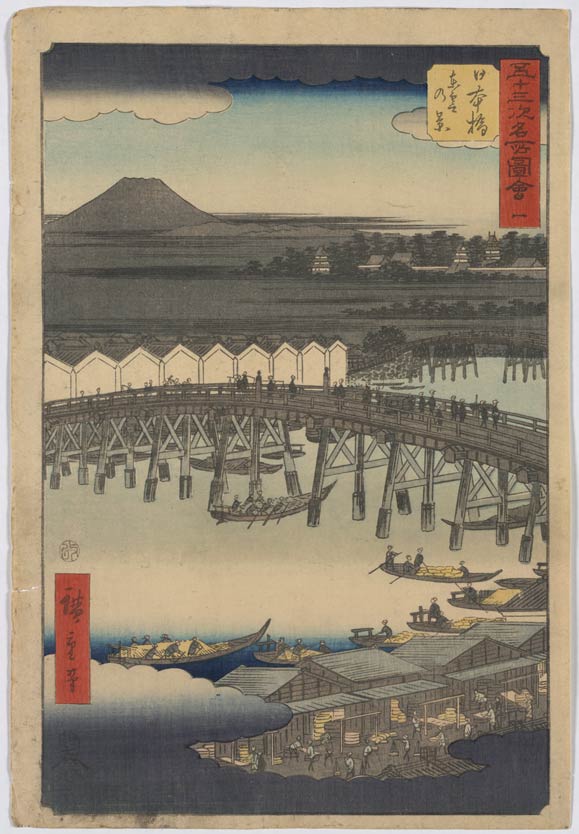
Andō Hiroshige, Nihonbashi, 1855, Woodblock print, 36.5x34.5 cm, Library of Congress
As students view a large image of Andō Hiroshige’s Nihonbashi,
Ask: What do you see in this print?
Ask: What colors are in this print?
Have students locate repeated colors. Remind students that each color was printed with a separate block.
(See Lesson 2 for more information about Japanese block printing.)
Ask: Overall, how would you describe the colors of this print?
Read Whistler’s comment on Japanese use of color:
Look how the Japanese understand this! the same colour reappearing continually here and there like the same thread in an embroidery … the whole forming in this way an harmonious pattern.
- James McNeill Whistler
Ask: Where are large areas of space in this print?
Where are large blocks or bands of dark objects or areas?
2. » Whistler, James McNeill Whistler, Arrangement in Grey and Black No.1, Portrait of the Artist's Mother, 1871, Oil on canvas, 144.3x162.5 cm, Musée d’Orsay, Paris (High Resolution file).
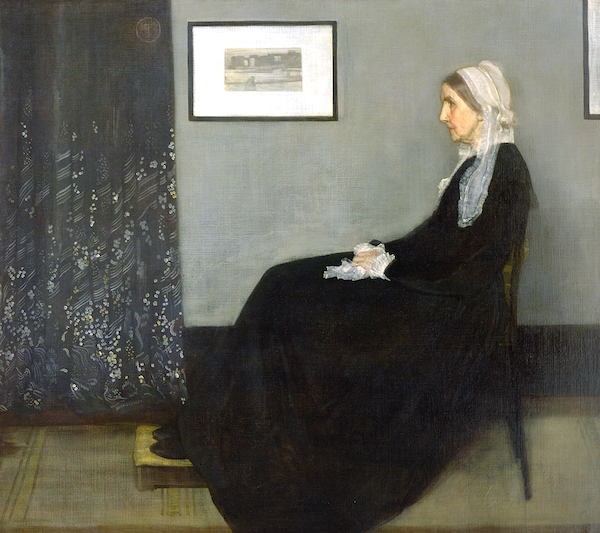
"Arrangement in Grey and Black No.1, Portrait of the Artist's Mother," 1871, Oil on canvas, Courtsey of the Musée d'Orsay, Paris, France
As students view a large image of Whistler’s portrait of his mother tell them that even though Whistler’s subject is very different from Hiroshige’s print, there are many similarities between these two works of art.
Ask: What is the subject of this painting?
Show students a photograph of Whistler’s mother, Anna McNeill Whistler, 1870s, Photograph, Freer Gallery of Art and Arthur M. Sackler Gallery Archives (High Resolution file) so they can see how realistically Whistler captured his mother’s features. Even though this is a realistic likeness of his mother, Whistler discounted the value of its exact realism.
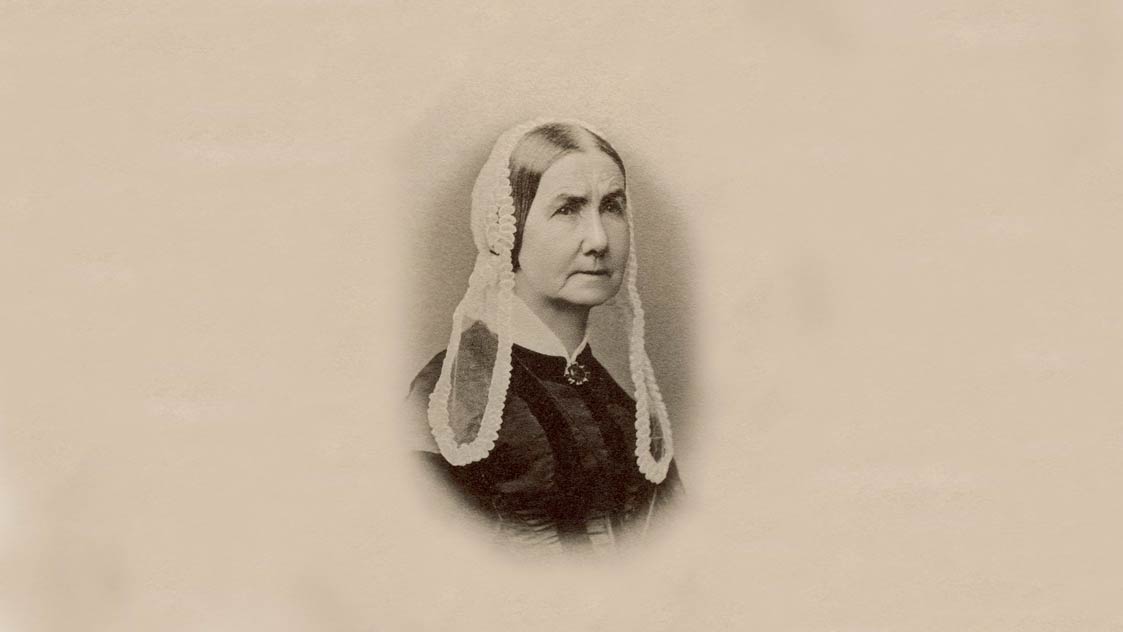
Anna McNeill Whistler, 1870s, Photograph, Freer Gallery of Art and Arthur M. Sackler Gallery Archives
Read Whistler’s quote about this painting and what he hoped to achieve in it:
"Art should be independent of all clap-trap—should…appeal to the artistic sense of eye or ear, without confounding this with emotions entirely foreign to it…Take the picture of my mother…as an Arrangement in Grey and Black. Now that is what it is…what can or ought the public care about the identity of the portrait?”
-James McNeill Whistler
Ask: Besides Whistler’s mother, what else is in this painting?
Ask: What colors are in this painting?
Ask: Compare Whistler’s color scheme to Hiroshige’s Nihonbashi print.
As Whistler tried to create harmony within his paintings, he experimented with Japanese color harmonies.
Ask: Where are large dark shapes?
Ask: Where are large blank spaces?
3. » James McNeill Whistler, Nocturne: Blue and Gold--Southampton Water, 1872, Oil on canvas, 50.5x76 cm, Art Institute of Chicago, Stickney Fund (High Resolution file).
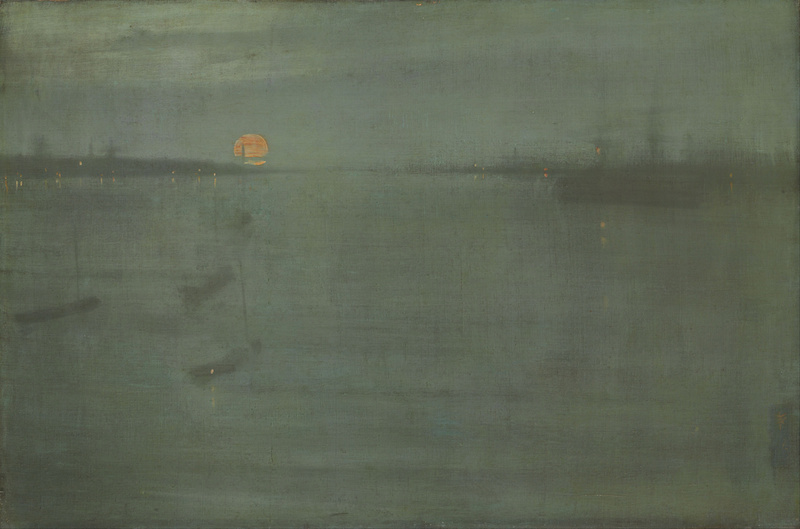
"Nocturne: Blue and Gold -- Southampton Water," 1872, Oil on canvas, Courtesy Art Institute of Chicago, Stickney Fund
As students view a large, bright image of Whistler’s Nocturne Southampton Water,
Ask: What do you see in this painting?
Ask: Describe the colors.
Locate bands of color in the water and sky.
Ask: How are the colors in this painting like those of the “Portrait of the Artist’s Mother”?
Ask: Which has the most abstract subject matter?
Read Whistler’s quote on Lesson 4.1 Small Images and Quotes Sheet.
“As the light fades and the shadows deepen, all petty and exacting details vanish, everything trivial disappears, and I see things as they are in great strong masses … And that, night cannot efface from the painter's imagination.”
-James McNeill Whistler
Ask and discuss: How do Whistler’s Arrangement in Grey and Black No 1, Portrait of the Artist’s Mother and his Nocturne: Blue and Gold – Southampton Water demonstrate his philosophy of art as expressed in the quotes about these works on the Lesson 4.1 Small Images and Quotes Sheet?
Have students complete the Venn diagram on the Lesson 4.2 Compare Hiroshige, Mother, Nocturne Worksheet (Word Document) to compare the Hiroshige print Nihonbashi, and Whistler’s paintings Arrangement in Grey and Black No.1, Portrait of the Artist's Mother and Nocturne: Blue and Gold--Southampton Water.
Review and discuss students’ comparisons on the Venn diagram. Their comparisons may be similar to the following: (Shaded cells indicate similarities.)
Hiroshige, Nihonbashi | Whistler, Portrait of The Artist’s Mother | Whistler, Nocturne: Blue and Gold – Southampton Water | |
Medium | Woodblock print | Oil painting | Oil painting |
Subject | Landscape, river with boats, bridge, mountain | Portrait (Whistler might have considered the composi-tion to be the subject.) | Landscape, water with boats, moon |
Color (Colors may vary due to differences in monitors and projectors.) | Cool blue grays with bits of pale yellow, red signature and title blocks | Cool blue grays with bits of pale yellow, a little pink | Dark, cool blue grays with dots of yellow orange |
Composition | Horizontal bands of space and dark land form the landscape. | Horizontal bands are in background. Space balances the figure shape. Curtain and baseboard anchor figure to edges. | Thin dark horizontal band of land divides sky. Clouds are in large sky and ripples are in water spaces. |
Style/realistic detail / abstraction | Space is flattened, but there are many recognizable details. | Face is realistic; background is simplified. Arrangement (composition) is most important. | Barely recognizable objects are realistic for a night view, but this is the most abstract of the three artworks. |
Activity 2. View Falling Rocket
Teacher Instructions:
As students view a large, bright image of Whistler’s Nocturne in Black and Gold, The Falling Rocket, 1875, Oil on panel, 60.2x46.7 cm, Detroit Institute of Arts, Gift of Dexter M. Ferry, Jr. (High Resolution file).
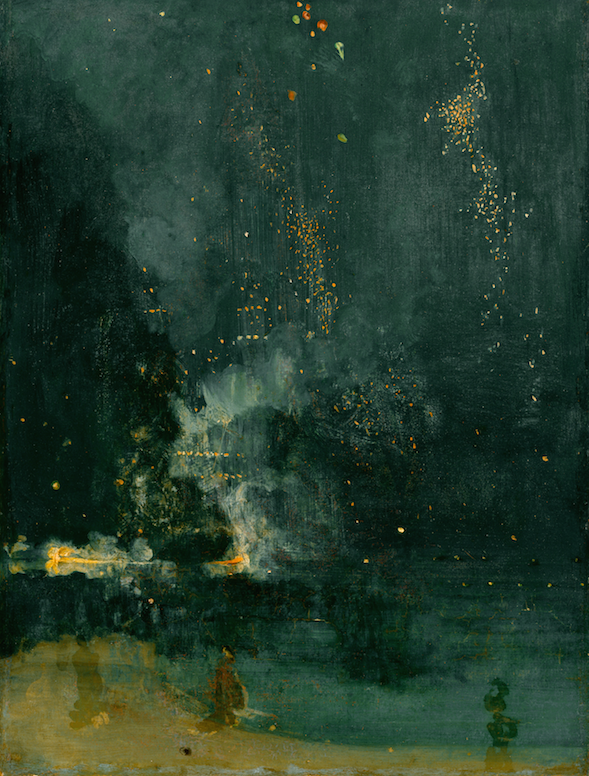
Nocturne in Black and Gold, The Falling Rocket, 1875, oil on panel, Courtesy Detroit Institute of Arts, Gift of Dexter M. Ferry Jr.
Ask: What do you see?
Ask: How is this Falling Rocket like Nocturne: Blue and Gold – Southampton Water?
Ask: What does the title, Nocturne in Black and Gold, The Falling Rocket, suggest about the art?
The Cremorne Pleasure Gardens on the northern bank of the river Thames were near where Whistler lived in Chelsea. This rocket is like fireworks trailing downward, but there are rows of stationary lights too. Wispy indications of figures are in the foreground.
Ask: Would you recognize the subject without the title? How important is the subject?
Activity 3. Read Whistler v. Ruskin: Aesthetics on Trial
» Lesson 4.3 Whistler v. Ruskin: Aesthetics on Trial (Word Document).
» Lesson 4.3 Whistler v. Ruskin: Aesthetics on Trial (PDF Document).
» Art Images: Whistler, Nocturne in Black and Gold, The Falling Rocket

Nocturne in Black and Gold, The Falling Rocket, 1875, oil on panel, Courtesy Detroit Institute of Arts, Gift of Dexter M. Ferry Jr.
Teacher Instructions:
Before students read the essay, Lesson 4.3 Whistler v. Ruskin: Aesthetics on Trial, review unfamiliar terms or vocabulary.
- Aesthetics is an idea or notion about what constitutes beauty or art.
- Two hundred guineas is approimately $20,000 in today’s money.
- A farthing was worth ¼ penny in 1878.
After students have read Lesson 4.3 Whistler v. Ruskin: Aesthetics on Trial, discuss the effectiveness and impact of both Ruskin’s and Whistler’s language describing art. Invite students to roleplay John Ruskin voicing his criticism and the Whistler v. Ruskin trial in which Whistler defends his art. Student actors may play Ruskin, Whistler, Sir John Holker (defense lawyer), and imaginary London newspaper readers voicing their opinions about the trial.
Encourage students to express their own opinions about:
- the trial,
- what makes something fine art,
- how much a piece of art is worth, and
- who determines what is fine art.
Ask:
Why would someone like Nocturne in Black and Gold, The Falling Rocket?
Who would not consider this fine art?
In 1987 one of Whistler’s paintings sold for $2.58 million. In 2010, one of his etchings, Nocturne, sold for $282,000.
Activity 4 Assessment. Write an Analytical Criticism of Nocturne in Black and Gold, The Falling Rocket
» Lesson 4.4 Assessment of Critical Analysis of Falling Rocket assignment (Word Document).
» Lesson 4.4 Assessment of Critical Analysis of Falling Rocket assignment (PDF Document).
Teacher Instructions:
Assign students to write an analytical criticism of James McNeill Whistler’s painting Nocturne in Black and Gold, The Falling Rocket. They should describe it and explain why they do or do not consider this fine art. In their response they should refer to or quote Whistler, Ruskin, or other art critics to support their opinion. See Lesson 4.4 Assessment of Critical Analysis of Falling Rocket Assignment.
Activity 5 Studio. Paint a Nonliteral Scene from Memory
Teacher Instructions:
Lead students on a walking tour of an outdoor area. This could be on a field trip or around an area near their school. As they walk, encourage them to notice and point out what they see. Ask them to describe the light, shadows, and colors of the area. How do they feel about this area? Does it have a mood such as spooky, scary, trashy, beautiful, peaceful, or mystical? What colors might suggest this mood?
Have students use their memory to paint a nonliteral scene of the area they just viewed. They may wish to create this artwork with acrylic, oil, or tempera paint or with pastels. Remind students that Whistler painted his nocturnes from memory.
Instruct students to title their paintings and write artists’ statements explaining their art and what they were attempting to show. Display the students’ art with their artists’ statements.
Activity 6 Lesson Extension: Hiroshige and Whistler Comparison
» Art Image: Hiroshige’s Nihonbashi, 1855
» Art Image: Whistler’s Brown and Silver: Old Battersea Bridge
» Art Image: Old Battersea Bridge
Teacher Instructions:
Direct students to compare Hiroshige’s Nihonbashi to Whistler’s Brown and Silver: Old Battersea Bridge and Old Battersea Bridge. Students should consider if they are alike in subject, color, and composition.
Activity 7 Lesson Extension: Compare Bridges by Hiroshige, Whistler and Monet
Teacher Instructions:
Many French Impressionist paintings are similar to Whister’s nocturnes. Like Whistler, French Impressionists were intrigued by Japanese prints. Invite students to research Monet’s paintings of bridges and compare one of Monet’s bridge paintings to Hiroshige’s and Whistler’s.
Activity 8 Lesson Extension: Read an Art Review
Teacher Instructions:
As in Whistler’s day, art critics still write reviews of art exhibits. They influence who attends these exhibits and purchases art. Have students read an art review in their local newspaper or in The New York Times.
Assignments
» Lesson 4.4 Assessment Rubric for Critical Analysis of Falling Rocket Assignment
Assignment: Write a Critical Analysis of Falling Rocket
View James McNeill Whistler’s painting Nocturne in Black and Gold, the Falling Rocket.
Read the essay Whistler v. Ruskin: Aesthetics Trial.
Write a description and analysis of the painting. Include information about color, composition, subject, and style (abstract, realism). Write neatly using understandable and appropriate grammar.
Critique the painting. Explain why you do or do not consider this painting to be fine art. Include Whistler’s, John Ruskin’s, or other art critics’ opinion to support your argument.
» Art Images: Whistler, Nocturne in Black and Gold, The Falling Rocket
» Lesson 4.3 Whistler v. Ruskin: Aesthetics on Trial (Word Document).
» Lesson 4.3 Whistler v. Ruskin: Aesthetics on Trial (PDF Document).
» Lesson 4.4 Assessment Rubric for Critical Analysis of Falling Rocket Assignment
|
Excellent |
All Right, O.K. |
Needs |
Unacceptable |
|
|
Description |
Appropriately described Whistler’s painting. Accurately described color, arrangement (composition), subject, and style (abstract, realism). |
Described Whistler’s painting and its color, arrangement (composition), subject, style (abstract, realism), but part of description is inaccurate or vague. |
Attempted to describe Whistler’s painting. Did not accurately describe color, arrangement (composition), subject, or style. The description is inaccurate or vague. |
Did not describe Whistler’s painting. Did not describe color, arrangement (composition), subject, or style. |
|
Writing |
Composition was very well written and understandable. |
Composition was well written and for the most part was understandable. |
Composition was difficult to understand due to poor grammar or spelling. |
Composition was poorly written, not understandable. |
| Critique |
Logical understandable argument for or against considering Falling Rocket as fine art is given. Whistler’s, Ruskin’s, or other art critic’s opinion is included to support personal opinion. |
Argument for or against considering Falling Rocket as fine art is given, but may not be well stated. Whistler’s, Ruskin’s, or other art critic’s opinion is included to support personal opinion. |
Argument for or against considering Falling Rocket as fine art is attempted. May be difficult to understand. Whistler’s, John Ruskin’s, or other art critic’s’ opinion is included. |
Argument for or against considering Falling Rocket as fine art is not stated. Whistler’s, Ruskin’s, or other art critic’s opinion is not included. |


